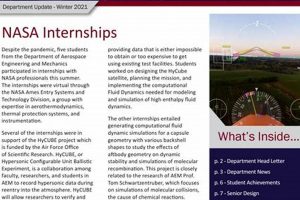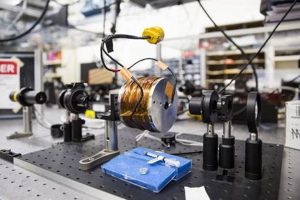The challenge presented by a career in flight and space vehicle development is significant. This field demands a strong foundation in mathematics, physics, and computer science, along with the ability to apply these principles to complex design problems. The curriculum involves rigorous coursework and demanding project work, pushing students to their intellectual limits. For example, designing a stable control system for a hypersonic aircraft requires mastery of advanced aerodynamics, control theory, and materials science.
The demanding nature of this discipline stems from the critical nature of its applications. Failures can have catastrophic consequences, underscoring the need for precision, accuracy, and meticulous attention to detail. Professionals in this sector contribute to advancements in air travel, space exploration, and national defense, shaping technological progress and expanding the boundaries of human understanding. Historically, the pursuit of flight has driven innovation in materials, propulsion systems, and communications, with applications that extend far beyond the aerospace industry itself.
Understanding the specific areas that contribute to the level of intellectual demand and the resources available to mitigate these challenges provides a more complete picture. Therefore, the following sections will delve into the factors contributing to the perceived rigor of the curriculum, the problem-solving skills required, and the workload associated with the degree, as well as exploring the support structures designed to foster success.
Success in aerospace engineering necessitates a strategic approach to learning and skill development. The following tips offer guidance for students pursuing this demanding field.
Tip 1: Strengthen Foundational Knowledge: Solid proficiency in calculus, differential equations, linear algebra, and physics is essential. Consistent review and practice of these core subjects will build a strong base for advanced topics.
Tip 2: Master Computational Tools: Familiarity with software packages like MATLAB, Simulink, and CAD/CAM programs is critical for analysis, simulation, and design. Dedicated time spent learning these tools will significantly enhance problem-solving capabilities.
Tip 3: Develop Strong Problem-Solving Skills: Aerospace engineering relies heavily on applying theoretical knowledge to real-world problems. Regularly engaging in complex problem sets and seeking assistance when needed is crucial.
Tip 4: Seek Out Practical Experience: Internships, research opportunities, and participation in design projects offer invaluable hands-on experience. These experiences provide context for theoretical concepts and enhance employability.
Tip 5: Cultivate Effective Time Management: The workload in aerospace engineering is significant. Prioritizing tasks, creating a study schedule, and avoiding procrastination are key to managing time effectively.
Tip 6: Build a Strong Network: Connecting with professors, teaching assistants, and fellow students can provide access to valuable resources, support, and collaboration opportunities. Attend industry events to network with professionals.
Tip 7: Focus on Conceptual Understanding: Rote memorization is insufficient for long-term success. Strive to deeply understand the underlying principles and their applications.
These strategies provide a framework for mitigating the challenges associated with this field. Proactive implementation of these recommendations can significantly improve performance and overall learning experience.
Ultimately, the ability to adapt to challenges and apply acquired knowledge is a defining factor for success in this field. The following sections will discuss the job market and career opportunities available to graduates.
1. Abstract mathematics
The inherent complexity of aerospace engineering is inextricably linked to the application of abstract mathematical principles. These principles, often seemingly detached from tangible reality, form the bedrock upon which the design, analysis, and control of aircraft and spacecraft are built. The difficulty encountered within this field stems, in part, from the requirement to translate abstract equations and theorems into functional, physical systems. For instance, the stability analysis of an aircraft relies heavily on concepts from linear algebra and differential equations, transforming complex aerodynamic forces into manageable mathematical models. Without a firm grasp of these underlying mathematical structures, engineers are ill-equipped to predict and control the behavior of aerospace vehicles.
Consider the design of a satellite’s orbital trajectory. The calculation requires a deep understanding of celestial mechanics, which is fundamentally rooted in mathematical formulations of gravitational forces and orbital parameters. Furthermore, control systems for spacecraft attitude are designed using control theory, which relies heavily on complex mathematical models to ensure stability and precision. These are not mere theoretical exercises; inaccurate mathematical modeling can lead to catastrophic mission failures. The ability to manipulate and interpret these abstract concepts is, therefore, not just an academic exercise but a critical skill for ensuring the safety and efficacy of aerospace systems.
In summary, the connection between abstract mathematics and the demands within aerospace engineering is causal and profound. Mastering these mathematical foundations is not simply beneficial but rather essential for success in the field. The ability to translate abstract concepts into concrete applications is a defining characteristic of a skilled aerospace engineer, enabling innovation and ensuring the reliable operation of complex aerospace systems. The challenge lies in bridging the gap between theoretical abstraction and practical implementation, and overcoming this difficulty is paramount to advancing the field.
2. Complex Systems Integration
The difficulty inherent in aerospace engineering is significantly amplified by the necessity of integrating numerous complex systems into a unified, functional whole. This integration process demands a broad understanding of diverse engineering disciplines and the ability to manage intricate interdependencies.
- Software and Hardware Harmony
Aerospace vehicles rely on sophisticated software to control and manage hardware components. Integrating these two elements requires meticulous attention to detail, ensuring that the software accurately interprets sensor data, executes control algorithms, and communicates effectively with actuators. An example is the flight control system of an aircraft, where software interprets pilot commands, sensor readings, and external conditions to adjust control surfaces for stable flight. The complexity lies in ensuring seamless interaction between these domains, mitigating potential errors or conflicts that could lead to system failure.
- Interdisciplinary Collaboration
Successful aerospace projects require close collaboration among engineers from various specialties, including aerodynamics, propulsion, structures, and avionics. Each discipline brings its unique perspective and expertise, but effective integration requires clear communication, shared understanding, and a willingness to compromise. For example, designing a satellite’s communication system requires collaboration between electrical engineers, software engineers, and mechanical engineers, each contributing specialized knowledge to ensure that the system meets performance requirements and operates reliably in space. The difficulty arises from coordinating these diverse teams and resolving potential conflicts in design priorities.
- Managing Interdependencies
Aerospace systems are characterized by complex interdependencies, where the performance of one component directly affects the performance of others. Integrating these components requires careful consideration of these interactions, ensuring that the overall system operates optimally. A prime example is the integration of a jet engine into an aircraft’s airframe, where the engine’s thrust and fuel consumption directly impact the aircraft’s aerodynamic performance and stability. Engineers must model these interdependencies accurately and design the system to minimize adverse effects and maximize overall performance. The challenge lies in accurately predicting and managing these interactions, particularly under varying operating conditions.
- Verification and Validation
Ensuring the proper integration of complex systems requires rigorous verification and validation testing. This process involves subjecting the integrated system to a wide range of conditions to identify potential flaws or weaknesses. An example is the testing of a spacecraft’s propulsion system in a simulated space environment, where engineers evaluate its performance under extreme temperatures, vacuum conditions, and varying power levels. The difficulty lies in designing comprehensive test programs that adequately simulate real-world conditions and uncovering potential failure modes before deployment.
These facets of complex systems integration underscore the formidable demands of aerospace engineering. The successful execution of aerospace projects hinges on the ability to effectively manage and integrate diverse technologies, disciplines, and teams, thereby contributing significantly to the overall difficulty associated with this field.
3. High Safety Stakes
The inherently high stakes associated with aerospace engineering profoundly contribute to its demanding nature. The potential for catastrophic failure necessitates an unwavering commitment to precision, reliability, and rigorous testing, thereby escalating the complexity and difficulty of the field.
- Stringent Design Requirements
Aerospace components must adhere to exceptionally stringent design requirements to ensure safety under extreme conditions. For example, aircraft wings are designed to withstand stresses far exceeding those encountered during typical flight, incorporating safety factors to account for unforeseen circumstances. This requirement necessitates advanced analytical techniques and meticulous attention to detail, adding to the complexity of the design process.
- Rigorous Testing and Certification
All aerospace systems undergo exhaustive testing and certification processes to verify their safety and reliability. These tests often involve subjecting components to simulated flight conditions, extreme temperatures, and high levels of stress. For example, a jet engine undergoes extensive testing to ensure it can operate reliably under a wide range of conditions, including high altitudes, extreme temperatures, and varying fuel mixtures. Meeting these stringent testing requirements demands significant resources and expertise, further increasing the difficulty of the field.
- Redundancy and Fail-Safe Mechanisms
To mitigate the risk of failure, aerospace systems often incorporate redundancy and fail-safe mechanisms. These systems provide backup capabilities in the event of a component malfunction, ensuring continued safe operation. For example, aircraft typically have multiple hydraulic systems to control flight surfaces, ensuring that a failure in one system does not compromise the aircraft’s ability to maneuver. Designing and implementing these redundant systems adds complexity to the design and maintenance processes.
- Continuous Monitoring and Maintenance
Ongoing monitoring and maintenance are crucial for ensuring the continued safe operation of aerospace systems. Regular inspections, repairs, and component replacements are necessary to prevent failures and extend the lifespan of the system. For example, aircraft undergo routine maintenance checks to identify and address potential problems before they can lead to safety issues. This continuous monitoring and maintenance requirement demands a skilled workforce and sophisticated maintenance procedures, further contributing to the demanding nature of the field.
The combination of stringent design requirements, rigorous testing, redundancy, and continuous monitoring collectively underscores the influence of safety considerations on the overall rigor of aerospace engineering. The field demands an unwavering commitment to safety, necessitating a high level of expertise and meticulous attention to detail, ultimately increasing its difficulty compared to other engineering disciplines with lower safety implications.
4. Interdisciplinary Knowledge
Aerospace engineering’s inherent complexity is magnified by the breadth of knowledge required across numerous disciplines. This interdisciplinary nature necessitates a multifaceted skill set and contributes significantly to the field’s perceived and actual rigor.
- Aerodynamics and Fluid Mechanics
A fundamental understanding of how air flows around objects is essential for designing efficient and stable aircraft and spacecraft. This knowledge extends to computational fluid dynamics (CFD) for simulating airflow, demanding expertise in both physics and computer science. Incorrect aerodynamic design can lead to inefficiencies or catastrophic failures, requiring aerospace engineers to possess a deep understanding of these principles. The challenge lies not only in understanding these principles but also in applying them to complex geometries and operating conditions.
- Materials Science and Engineering
Aerospace vehicles operate in extreme environments, demanding materials that can withstand high temperatures, pressures, and radiation. Understanding the properties of various materials, including metals, composites, and ceramics, is crucial for selecting the right materials for each application. Engineers must consider factors such as strength, weight, corrosion resistance, and cost when making material selection decisions. The difficulty arises from the need to balance these competing factors and to predict material behavior under extreme conditions. This understanding needs to extend towards manufacturing techniques, such as forging, welding, and additive manufacturing.
- Electrical Engineering and Avionics
Modern aerospace vehicles rely heavily on electrical systems for power distribution, control, and communication. A solid understanding of electrical engineering principles is essential for designing and integrating these systems. Avionics, which includes navigation, communication, and flight control systems, further compounds the complexity. Integrating these systems requires a thorough understanding of both hardware and software, demanding expertise in both electrical engineering and computer science. An error in the design or integration of these systems can have catastrophic consequences.
- Propulsion and Thermodynamics
Propulsion systems are essential for generating the thrust required to propel aircraft and spacecraft. A comprehensive understanding of thermodynamics, combustion, and fluid mechanics is necessary for designing efficient and reliable engines. Engineers must consider factors such as fuel efficiency, thrust-to-weight ratio, and emissions when designing propulsion systems. The complexity arises from the need to optimize these factors simultaneously, often requiring advanced simulation techniques and experimental validation. This extends to unconventional propulsion techniques such as electric propulsion or advanced rocket designs.
The necessity of integrating these diverse disciplines into a coherent and functional design significantly elevates the demanding nature of aerospace engineering. The ability to synthesize knowledge from multiple domains and apply it to solve complex problems is a defining characteristic of a successful aerospace engineer. This interdisciplinary requirement constitutes a significant component of the overall difficulty associated with this field.
5. Continuous Learning
The dynamic nature of aerospace technology inextricably links continuous learning to the perceived and actual difficulty of aerospace engineering. Rapid advancements in materials, propulsion, avionics, and computational methods mandate an ongoing commitment to professional development. Stagnation in knowledge translates directly into professional obsolescence within a comparatively short timeframe. Consequently, the aerospace engineer must actively pursue new information and skills to remain competent and competitive. The need for constant adaptation introduces a continuous pressure to learn, contributing substantially to the overall perception of difficulty. For instance, the integration of artificial intelligence into flight control systems or the development of hypersonic vehicles necessitates the acquisition of specialized knowledge beyond the scope of traditional undergraduate curricula.
Practical significance arises from the necessity to implement emerging technologies safely and effectively. Aerospace engineers must continually update their understanding of regulatory frameworks, ethical considerations, and risk management strategies. Ignoring the evolving landscape of aerospace standards can lead to design flaws, safety hazards, and regulatory non-compliance. Consider the development of unmanned aerial vehicles (UAVs). Engineers must navigate the rapidly changing regulatory landscape governing UAV operations, including airspace restrictions, safety protocols, and privacy concerns. Furthermore, the increasing adoption of additive manufacturing requires understanding new material properties and manufacturing processes, including the potential for defects and the need for rigorous quality control measures. These examples underscore the critical role of continuous learning in ensuring the responsible and ethical application of new technologies.
In summary, continuous learning constitutes a fundamental component of the challenge posed by aerospace engineering. The need to adapt to technological advancements, regulatory changes, and evolving ethical considerations creates a constant pressure to acquire new knowledge and skills. While this commitment to lifelong learning presents a significant challenge, it is also essential for maintaining competence, ensuring safety, and driving innovation within this dynamic and demanding field.
Frequently Asked Questions
The following addresses common inquiries regarding the demands and challenges associated with a career in aerospace engineering.
Question 1: What specific mathematical skills are most crucial for aerospace engineers?
Proficiency in calculus, differential equations, linear algebra, and numerical methods is paramount. These mathematical tools are foundational for analyzing complex systems, modeling fluid dynamics, and designing control algorithms.
Question 2: How important is practical experience, such as internships, in preparing for a career in this field?
Practical experience is highly valuable. Internships, research opportunities, and design projects provide hands-on experience that complements theoretical knowledge. Such experiences enhance problem-solving skills and improve employability.
Question 3: What is the typical workload for an aerospace engineering student?
The workload is generally considered demanding, requiring significant time commitment for coursework, projects, and independent study. Effective time management and strong organizational skills are essential for success.
Question 4: How critical is it to stay current with technological advancements in aerospace engineering?
Continuous learning is essential. The aerospace industry is rapidly evolving, necessitating ongoing professional development to stay abreast of new technologies, materials, and design methodologies.
Question 5: What types of software skills are most beneficial for aerospace engineers?
Familiarity with software packages such as MATLAB, Simulink, CAD/CAM programs, and finite element analysis (FEA) tools is highly advantageous. These tools are used for simulation, analysis, and design optimization.
Question 6: How significant is the emphasis on safety in aerospace engineering education and practice?
Safety is of paramount importance. Aerospace engineers are responsible for designing and maintaining systems where failure can have catastrophic consequences. A strong emphasis on safety is integrated throughout the curriculum and professional practice.
In summary, a career in aerospace engineering demands a strong foundation in mathematics and science, practical experience, continuous learning, and a commitment to safety. The workload is considerable, but the rewards can be significant for those who are passionate about pushing the boundaries of flight and space exploration.
The next section will explore various career paths within the aerospace engineering field and the skills required for each.
In Conclusion
The preceding discussion has elucidated numerous facets contributing to the demanding nature of aerospace engineering. The convergence of abstract mathematical principles, complex systems integration, stringent safety requirements, interdisciplinary knowledge, and the necessity for continuous learning collectively define a field of considerable intellectual rigor. Mastering the fundamentals and applying them to real-world challenges requires unwavering dedication and a profound commitment to excellence.
The information presented should provide aspiring engineers a realistic perspective on the challenges and opportunities within aerospace engineering. Potential students should carefully consider their strengths and interests before embarking on this career path. Those who possess the aptitude and dedication to overcome these challenges will find themselves well-positioned to contribute to significant advancements in flight and space exploration.







